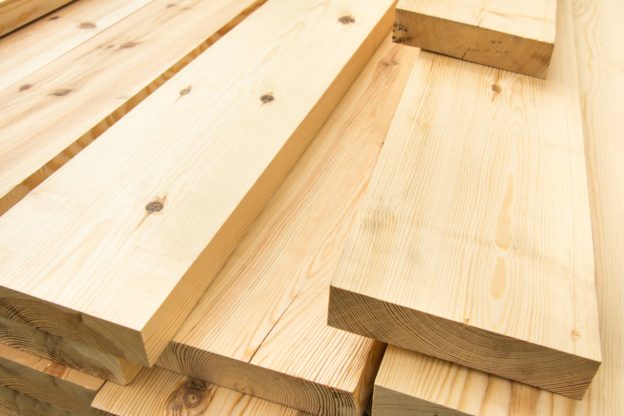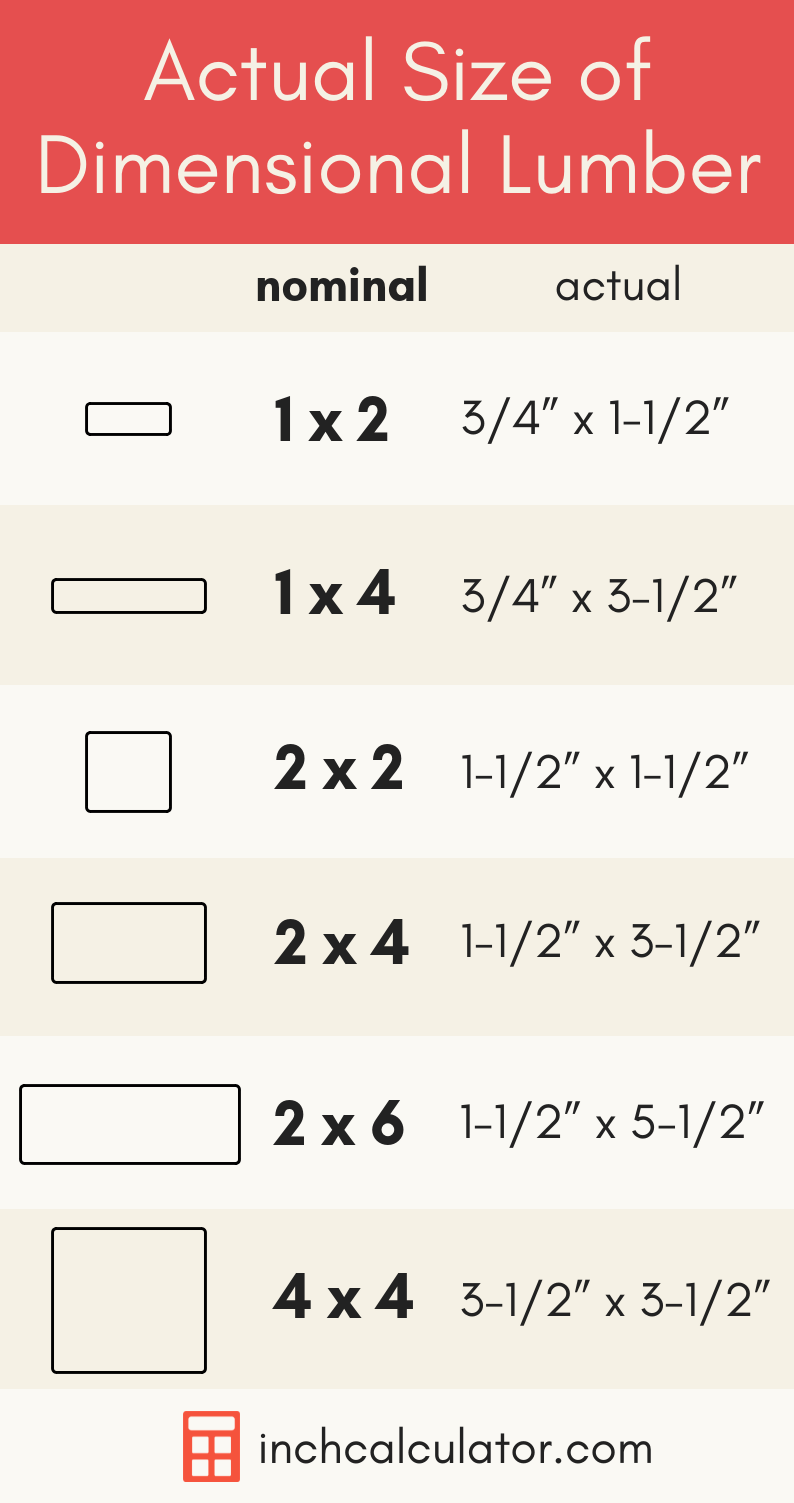Actual Size of Dimensional Lumber – Nominal Sizes Explained

You may have seen framing lumber and softwood boards sold by listed dimensions that don’t match the actual size of the board. Hopefully, you haven’t been burned by assuming that a 2×4 is actually two inches by four inches but if you have, know that you’re not alone.
In fact, most building materials are sold by nominal, rather than actual, sizes for a variety of reasons. For some, it’s historical while others may be in the way they are designed to be installed. Wood and lumber are no different, and for most dimensional lumber, you will find that the material is sold and listed by its nominal size, rather than its actual size.
Actual Size of Dimensional Lumber
Most softwood lumber sold at the lumber yard or home improvement store is dimensional lumber, such as pine or Douglas fir. Dimensional lumber is lumber that has been dried and milled to standard dimensions and is most commonly used for framing and construction.
Dimensional lumber is sold using what is referred to as the nominal dimensions of a board. These are the dimensions of the green board before it’s been dried and milled. The actual sizes of a board are smaller than that.
The Actual Size of a 2×4
For example, a 2×4 board is actually 1 1/2″ x 3 1/2″. The board is advertised and sold using nominal dimensions, which are a bit larger than the actual dimensions.
Actual Lumber Size Table
The table below shows the actual size versus the nominal size of various dimensional lumber products.
| Nominal Size | Actual Size (inches) | Actual Size (mm) |
|---|---|---|
| 1×2 | 3/4″ x 1 1/2″ | 19 mm x 38 mm |
| 1×4 | 3/4″ x 3 1/2″ | 19 mm x 89 mm |
| 1×6 | 3/4″ x 5 1/2″ | 19 mm x 140 mm |
| 1×8 | 3/4″ x 7 1/4″ | 19 mm x 235 mm |
| 1×10 | 3/4″ x 9 1/4″ | 19 mm x 235 mm |
| 1×12 | 3/4″ x 11 1/4″ | 19 mm x 286 mm |
| 2×2 | 1 1/2″ x 1 1/2″ | 38 mm x 38 mm |
| 2×4 | 1 1/2″ x 3 1/2″ | 38 mm x 89 mm |
| 2×6 | 1 1/2″ x 5 1/2″ | 38 mm x 140 mm |
| 2×8 | 1 1/2″ x 7 1/4″ | 38 mm x 184 mm |
| 2×10 | 1 1/2″ x 9 1/4″ | 38 mm x 235 mm |
| 2×12 | 1 1/2″ x 11 1/4″ | 38 mm x 286 mm |
| 4×4 | 3 1/2″ x 3 1/2″ | 89 mm x 89 mm |
| 4×6 | 3 1/2″ x 5 1/2″ | 89 mm x 140 mm |
If you’re stuck without a tape measure or reference table, you can also use a simple rule of thumb to determine the actual size of dimensional lumber.
- If the nominal size is smaller than 1″ then the actual size is 1/4″ smaller than the nominal size.
- If the nominal size is larger than 2″ and smaller than 8″ then the actual size is 1/2″ smaller than the nominal size.
- If the nominal size is 8″ or larger, then the actual size of the board will be 3/4″ smaller.
Why is dimensional lumber smaller than the nominal dimensions?
Historically, softwood logs were cut green into 2″ x 4″ planks but would naturally shrink as the boards dried out, and after planing and milling, they ended up around 1-1/2″ x 3-1/2″. Today, boards are intentionally cut large to allow for shrinkage during kiln drying and the milling process.
Because the amount a board shrinks can vary by wood species, moisture content, and even the individual tree, the final size may vary slightly. Modern sawmills typically account for this, however, and will mill the dried boards to a more exact size, making dimensional lumber generally consistent.
Plywood is thinner than the nominal thickness as well, but for a different reason. Learn more about the actual thickness of plywood.
Hardwood Lumber Sizes & Dimensions
Hardwood lumber such as oak, maple, or walnut is sold very differently from dimensional lumber and is usually measured by the board foot. Calculating board feet can be a little tricky, but it’s essentially just a measurement of the volume of the board.
A board foot is equal to 144 cubic inches, or a board that measures 12″ long by 12″ wide by 1″ thick.
Hardwood lumber is often sized by the thickness of the board, which is measured in quarters rather than inches. Quarters refer to the number of quarters of an inch of board thickness. For example, a 1″ thick board is referred to as 4/4.
To make things more confusing, hardwood lumber is also sold either rough-sawn or given a rough, finish surface on one, two, three, or all four sides. Boards that have been surfaced are referred to using the designations S1S, S2S, S3S, or S4S, depending on how many surfaces have been planed or sawn.
These designations are important since they impact the actual thickness of a board. For example, a 4/4 board is 1″ thick when it’s purchased rough, but is 7/8″ thick after surfacing one side and is 13/16″ thick after surfacing two sides. Refer to the table below to see the thicknesses of hardwood lumber that is rough or surfaced.
| Nominal Size | Rough Size (inches) | S1S Actual Size (inches) | S2S Actual Size (inches) |
|---|---|---|---|
| – | 1/2″ | 3/8″ | 5/16″ |
| – | 5/8″ | 1/2″ | 7/16″ |
| – | 3/4″ | 5/8″ | 9/16″ |
| 4/4 | 1″ | 7/8″ | 13/16″ |
| 5/4 | 1 1/4″ | 1 1/8″ | 1 1/16″ |
| 6/4 | 1 1/2″ | 1 3/8″ | 1 5/16″ |
| 8/4 | 2″ | 1 13/16″ | 1 3/4″ |
| 12/4 | 3″ | 2 13/16″ | 2 3/4″ |
Did you know you can also calculate the weight of lumber using one of our calculators?

Frequently Asked Questions
What does a 2x4 actually measure?
A 2×4 piece of dimensional lumber actually measures 1-1/2″ x 3-1/2″.
What are standard lumber sizes?
Standard sizes for dimensional lumber range from 2″ x 4″ to 2″ x 12″. However, sizing is nominal, and the actual sizes of the lumber are typically 1/2″ to 3/4″ smaller.
How do you identify dimensional lumber?
Dimensional lumber is the name given to framing lumber. The lumber is usually identified by the measurements of the green lumber before it was cut and dried, such as 2×4, 2×6, or 2×10.


